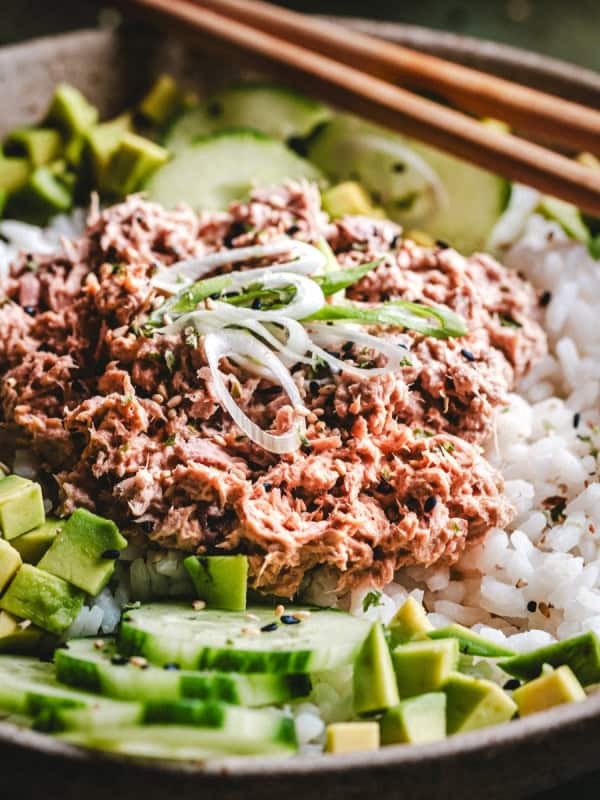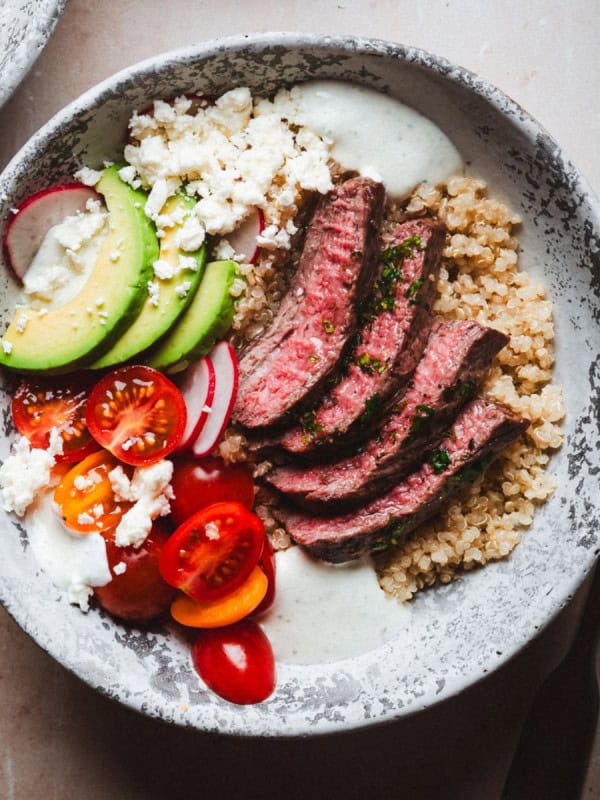This post may contain affiliate links. Please read our disclosure policy.
When weeknight dinners start feeling a bit too routine, I love making this Kung Pao Beef recipe. It’s one I turn to for those evenings when we want something exciting but don’t have much time to spare. I hope you’ll agree that there’s something so satisfying about creating those bold, restaurant-quality flavors at home.

Tender beef meets crunchy peanuts and vibrant bell peppers in a sauce that’s equal parts sweet, spicy, and savory—all ready in under 30 minutes. This dish transforms simple ingredients into a meal that’ll have you wondering why you ever bothered with takeout. It’s the kind of recipe that might just become a regular in your dinner rotation, just like it has in mine.
Table of Contents
Kung Pao Beef Ingredients

The Base
- Rice: I like to use jasmine rice for its fragrant aroma, but any long-grain white rice works well. Brown rice is also a great option if you prefer.
Marinating the Beef
- Flank Steak: Look for a piece without excessive marbling that’s an even thickness for consistent cooking.
- Soy Sauce: I prefer naturally-brewed or organic options for better flavor. If you’re gluten-free, tamari is a great alternative.
- Rice Vinegar: This adds a subtle tang. Make sure it’s unseasoned rice vinegar – the seasoned variety has added sugar and salt.
- Cornstarch: A key ingredient for that velvety sauce texture. It also helps create a nice crust on the beef when stir-frying.
- Baking Soda: Just a pinch tenderizes the beef beautifully. Don’t skip this!
To Make the Sauce
- Soy Sauce: Same as above.
- Water: Use filtered water if possible.
- Sichuan Peppercorns: Also called Szechuan Peppercorns, these give the dish its signature numbing spice.
- Rice Vinegar: Same as above.
- Hot Chili Paste: I use sambal oelek for its bright, fresh chili flavor. Sriracha works too if that’s what you have on hand.
- Honey: Adds a touch of sweetness to balance the heat. I love how it helps the sauce caramelize slightly.
For the Stir-Fry
- Avocado Oil: I prefer this for its high smoke point. Peanut or vegetable oil are good alternatives for high-heat cooking.
- Garlic: Fresh is best here. Look for firm bulbs with tight, unbroken skin.
- Fresh Ginger: Choose pieces that are firm and smooth. I find young ginger works best in stir-fries.
- Red Bell Pepper: Pick one that’s bright red and feels heavy for its size. It adds a sweet crunch to the dish.
- Green Onions: Look for bright green stalks with firm white ends. They add a fresh, oniony kick
- Roasted Peanuts: These add a wonderful crunch. I prefer unsalted to control the overall saltiness of the dish.
- Red Pepper Flakes: Optional, but great for an extra kick of heat. Adjust to your spice preference.
The Origins of Kung Pao
The Kung Pao style has its roots in the Chinese culinary tradition, specifically from the Sichuan province. The dish originally featured chicken and was named in honor of Ding Baozhen, a Qing Dynasty official. His nickname, “Ding Gongbao,” gives the dish its name. “Gongbao” is an abbreviation of an appointment he held, known as “Taizi Shaobao,” which translates roughly to “Crown Prince’s Tutor,” while “Ding” is his family name. Over time, the dish has been adapted to include other proteins like beef, but the essence of the dish—its sweet, spicy, and savory flavors—remains true to its origins.

6 Recipe Tips
- Freeze for easy slicing: I like to pop my flank steak in the freezer for about 15 minutes before slicing. It firms up the meat just enough to make cutting those thin, even strips much easier.
- Sauce prep: Mixing the sauce ingredients ahead of time ensures everything is well combined. I give it a quick stir right before adding to the pan since the cornstarch can settle.
- Heat management: I start with high heat for searing the beef, then reduce to medium for the aromatics and vegetables. This helps control the cooking process and prevents burning.
- Timing is key: I aim to have my rice finished cooking just as the stir-fry is done. This way, everything’s hot and ready to serve at the same time.
- Adjust the heat: The recipe calls for a tablespoon of chili paste, but feel free to start with less and add more at the end if you prefer. It’s all about finding your perfect spice level.
- Peanut crunch: While the recipe adds peanuts during cooking, I sometimes reserve a few to sprinkle on top for extra crunch just before serving.

Recipe Options
- Nuts: Cashews or almonds work as a substitute for peanuts. I’ve tried both, and while they change the flavor profile slightly, they still add that essential crunch.
- Additional Veggies: Sliced zucchini, mushrooms, green beans, or carrots can add a new dimension of flavor and texture. I particularly love adding water chestnuts for extra crispness.
- Grain Options: If you’re not in the mood for rice, try serving this over cauliflower rice for a low-carb option, or with noodles for a different texture.
- Sauce Variations: For a fruitier twist, try adding a tablespoon of hoisin sauce to the mix. Or, if you like it tangier, a splash of Chinese black vinegar works wonders.
Mistakes to Avoid
- Heat Levels: Spice cautiously. I’ve learned it’s much easier to add more heat later than to try to cool down an overly spicy dish.
- The Right Cookware: Don’t underestimate the importance of a wide skillet. It gives the beef room to sear instead of steam, which is key for developing those rich flavors.
- Order of Ingredients: Follow the recommended sequence. I’ve found it really does make a difference in how the flavors come together.
- Ingredient Preparation: Take your time with prep. Evenly sliced beef and finely minced garlic and ginger ensure every bite is as good as the last. I’ve rushed this before, and it’s not worth it.
- Essential Ingredients: For authentic Kung Pao flavor, Sichuan peppercorns are a must. Their unique, tingly spice is hard to replicate. If you can’t find them, black peppercorns will work in a pinch, but the flavor profile will be different.

Storing & Reheating
Leftover Kung Pao Beef can be refrigerated in an airtight container for up to 4 days. To reheat, sauté in a skillet over medium heat until warmed through.
Whether you’re a longtime fan of making Chinese cuisine or just getting started with homemade stir-fries, I think you’ll agree that this Kung Pao Beef recipe is a fantastic place to start. It’s a dish that proves you don’t need a wok or years of experience to create something truly delicious. So fire up that skillet, embrace the sizzle, and get ready to add a little spice to your weeknight dinner routine!
More Must Try Kung Pao Recipes
More Asian-Inspired Recipes To Try
How to Make Kung Pao Beef
(Prepare rice as instructed on the package, aiming to have it ready with the beef.) Combine soy sauce, rice vinegar, cornstarch, and baking soda in a bowl. Mix in the beef slices to marinate. Set it aside.


In a separate bowl, blend soy sauce, water, chili paste, honey, rice vinegar, Sichuan peppercorns, and cornstarch. Heat avocado oil in a wide skillet on high until it’s near smoking. Quickly sear the beef for about 2 minutes each side, then remove and set aside. In the same skillet, add another tablespoon of oil. Briefly sauté garlic and ginger. Toss in bell pepper and green onions, cooking until slightly soft.





Return the beef to the skillet. Re-stir the sauce mixture and pour it in, scraping any residue. Bring to a brief boil, then simmer until the sauce thickens. Divide among individual bowls, top with peanuts and optional red pepper flakes, and serve with hot rice.




Kung Pao Beef

Ingredients
- 1 cup rice
For the Beef
- 1 tablespoon soy sauce
- 1 tablespoon rice vinegar
- 1 tablespoon cornstarch
- 1/8 teaspoon baking soda
- 1 pound flank steak thinly sliced across the grain
For the Sauce
- 3 tablespoons soy sauce or reduced sodium soy sauce
- 1/4 cup water
- 1 tablespoon rice vinegar
- 1 tablespoon hot chili paste such as sambal oelek
- 1 tablespoon honey
- 1 teaspoon Sichuan peppercorns (also called Szechuan peppercorns) coarsely ground in a spice grinder or well crushed with a mortar and pestle or a rolling pin
- 1 teaspoon cornstarch
For the Stir Fry
- 3 tablespoons avocado oil divided
- 3 cloves garlic minced
- 2 tablespoons minced peeled fresh ginger
- 1 red bell pepper seeds and membrane removed, diced
- 6 green onions white and green parts, cut diagonally into 2-inch pieces, plus more, sliced for garnish (optional)
- 1/2 cup roasted unsalted peanuts
- red pepper flakes to taste
Instructions
- Cook rice according to package directions. (You'll want it to be cooked and hot at the same time that you're ready to serve the beef.)
For the Beef
- In a medium bowl, whisk together soy sauce, rice vinegar, cornstarch and baking soda; add sliced beef and toss well to coat. Set aside.1 pound flank steak, 1 tablespoon soy sauce, 1 tablespoon rice vinegar, 1 tablespoon cornstarch, 1/8 teaspoon baking soda
For the Sauce
- In another medium bowl, whisk together soy sauce, water, chili paste, honey, rice vinegar, crushed Sichuan peppercorns and cornstarch until well combined. Set aside.3 tablespoons soy sauce, 1/4 cup water, 1 tablespoon rice vinegar, 1 tablespoon hot chili paste, 1 tablespoon honey, 1 teaspoon Sichuan peppercorns, 1 teaspoon cornstarch
For the Stir Fry
- Heat 2 tablespoons of the avocado oil in a large skillet over high heat until nearly smoking. Add beef in a single layer and sear, 1 1/2 to 2 minutes per side. Reduce heat to medium and transfer beef to a clean plate.
- To same skillet, add remaining 1 tablespoon of avocado oil. Add garlic and ginger; cook and stir until fragrant, about 30 seconds. Add bell pepper and green onions; cook and stir 2-3 minutes until just tender.3 cloves garlic, 2 tablespoons minced peeled fresh ginger, 1 red bell pepper, 6 green onions
- Return beef and any accumulated juices to skillet. Stir soy sauce mixture (cornstarch will have sunk to the bottom) and add to skillet, scraping up any browned bits; bring to a boil. Reduce heat and simmer, stirring constantly until sauce is thickened and bubbly, 1-2 minutes. Transfer to serving platter or divide among 4 bowls. Sprinkle with peanuts and red pepper flakes (optional); serve with hot cooked rice.1/2 cup roasted unsalted peanuts, red pepper flakes
Nutrition
Nutrition information is automatically calculated, so should only be used as an approximation.
















This is a wonderful recipe! And it’s not to sweet, as many are.
Thank you, Mimi! I’m so glad you enjoyed it!